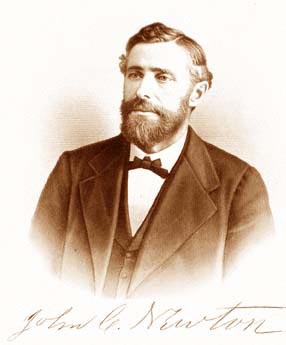 John C. Newton.In 1858 he graduated at the normal school in Westfield, and during the following year taught school in Vermont and Massachusetts. In 1860 he began his career as a builder by erecting the gas-works at Westfield and Greenfield, and an addition to the State normal school in Westfield. In 1861 he built the bridges on the Tunnel Railroad. In 1862 he came to Holyoke and built the Lyman Street school-house, the high school, and the wire-mills. Now Whiting Paper Company's No. 1 Mill. In 1863 he built A.T. Stewart & Co.'s woolen-mill and the Holyoke Machine Company's building; also W.H. Wilkinson and Emerson Wright's blocks, Wilkinson's collar factory, Stebbins' brass-foundry, and four private dwellings for employés of the United States Armory in Springfield, Mass. In 1864 he built the Florence Sewing-Machine Company's buildings, enlarged Monson Academy (at Monson, Mass.), and built the Holyoke Warp Company's mill and nine dwellings. In 1863 he built Tenement Block for the Hampden Paper Company's mill; also the Franklin Paper Company's mill and two dwellings on Race Street. Nov. 28, 1865, he married Miss Lela F. Vulte, of New York City. In 1866 he was elected manager of the Hampden Paper Company's Mill, of which he was also treasurer and principal owner. In 1867 he built the Hampden Paper Company's Mill No.2, now Crocker Manufacturing Company's Mill No. 1. In 1869 he added the second machine and engines to Hampden paper Company's Mill No. 2. During the summer and fall of 1870 he rebuilt this mill, which was destroyed by fire in March; he also put in water connections and laid the foundation of the Prentiss Wire-Mill and Whiting Paper Company's Mill No. 2. In 1871 he sold the Hampden Paper Company's mill to the Crocker Manufacturing Company, and forming a partnership with his oldest brother D.H. Newton, they purchased the Ryder property, and sold the site for the city-hall. He also built the Massasoit Paper Company's mill, the Springfield Blanket Company's mill and others, including the Beebe & Holbrook mill. In 1873 he built the paper-mill at Union Village, Conn., and the Jessup and Laflin paper-mill at Salmon Falls. He built the fishway at the Holyoke dam, also the Massachusetts Screw Company's mill, and graded the land above the first canal level, requiring four hundred thousand yards for filing. In 1874 he built the Farr Alpaca Company's mill, the Skinner silk-mill, and the dam for the Agawan Canal Company on the Agawan River. During the same year he organized the Massachusetts Screw Company, D.H. Newton, president, J.C. Newton, treasurer and principal owner. The greater part of the following year he spent in California for the benefit of his health. During the latter part of the year he erected buildings for the Chapman Cutlery Company, the Seymour Cutlery Company, J.C. Smith's machine-shops, and Joseph Peal and Connor Brothers' woolen-mills. In 1876 he built the Newton Paper Company's Mill No. 2, the Connecticut River Pulp-Works (running the latter with his brother Daniel H.). He also built seven cottages on Newton Street. In 1877 he built the Albion Paper Company's Mill No. 1, and a saw-mill for himself on Dwight Street. In 1878 he erected twenty Quaker houses and two tenements on Bond Street, nine houses on Newton Street, and a block for the Albion Paper Company. In 1879 he built the Wauregan paper-mill on Dwight Street, and an addition to the Newton Paper Company's mill for four engines and three paper-machines. He also repaired the dam at Huntington for the Massasoit Paper Company., which was washed away by the flood, Dec. 10, 1878. While the above is not an entire list of buildings erected by J.H. Newton, the principal ones have been enumerated, and comprise probably a larger number than has ever been erected by any single person in Western Massachusetts, and shows what perseverance and energy can accomplish. Mr. Newton has been largely interested in inducing capitalists and manufacturers to establish themselves in and around Holyoke. Mr. Newton's family now consists of his wife and four daughters, aged respectively three, five, eight, and ten years.
| HolyokeMass.com Blog
| HolyokeMass History | Hampden County |
| Western Mass History & Genealogy |
© Laurel O'Donnell 1997 - 2012, all rights reserved
This is an adaptation of the original publication This document may be downloaded for personal non-commercial use only and cannot be reproduced or distributed without permission. |